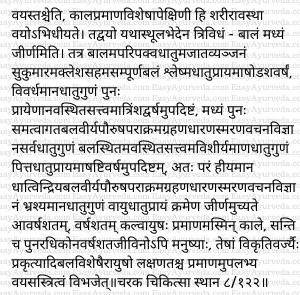Vaya Pariksha Examination Of Age Of The Patient, Importance
By Dr Raghuram Y.S. MD (Ay) & Dr Manasa, B.A.M.S
Examination of age is the 10th factor to be considered in the examination of patients as explained by Master Charaka in the 10 fold examination. The age factor is an important aspect which needs to be considered. Different diseases are manifested at different ages. The medicines and therapies, their quantity in terms of dosage and strength of the medicines prescribed too will vary according to age.
Vaya = age
Pariksha = examination
Vaya Pariksa means examination of the age of the patient.
Read – 10 Factors Of Patient Examination – Dasha Vidha Atura Pareeksha

Table of Contents
Examination of age in the patient

The patient should also be examined by age factor. Age is defined as the stage of the body depending on different quantities of time period.
This age factor is roughly of 3 kinds. They are –
1. Bala – childhood
2. Madhya vaya – middle age
3. Jirna vaya – old age
Read – Doshas in Relation to Age, Season and Time of Day
Bala Avastha
This stage of age is divided into two phases.
1. Phase 1 – Aparipakva Dhatu
Here the tissues of the body are incompletely mature or immature. This age ranges from 1 – 16 years of age.
Features of first stage of bala avastha –
| Sl No | Feature | Meaning |
| 1 | Aparipakva dhatu | immature / incomplete formation and maturation of tissues in the body |
| 2 | Ajata vyanjanam | the signs of youth are not manifested i.e. the beard, moustache etc do not appear |
| 3 | Sukumara | delicate nature of the body |
| 4 | Aklesha saham | cannot tolerate hardships of life |
| 5 | Asampurna balam | the strength and endurance of the body too is incomplete i.e. not totally present |
| 6 | Shleshma dhatu prayam | Predominance of kapha can be seen in this age |
From the treatment perspective, diseases occurring in this phase shall be dealtby using mild potency medicines, herbs and formulations, in lower doses.
2. Phase 2 – Vardhamana Dhatu
Here the tissues of the body are in a state of growth and maturation. This age ranges from 17 – 30 years of age.
Features of 2nd stage of Bala Avastha –
– Vivardhamana dhatu gunam – the tissues are in a constant state of growth and maturation, quicker and steadier than the first phase of bala stage
– Prayena anavasthita sattvam – mostly in all persons of this stage the mind is in an unstable condition i.e. there is fluctuation and fickleness of mind and the person is attracted towards untoward and undesired sense objects
From the treatment perspective there will be no restriction of giving mild potency medicines or medicines in lower doses. Bigger doses of strong medicines can be tried at this age to combat the illness. Similarly stronger therapies in comparison to the 1st phase can also be administered skillfully.
Read – How Dose Of Ayurvedic Medicine Is Decided? 7 Factors
Madhya Vaya
This stage comprises persons in the age group of 31-60 years. Features of persons in middle age –
1. The below mentioned features will be balanced and well defined and matured –
Bala – strength
Virya – potency
Paurusha – valor
Parakrama – valor
Grahana shakti – grasping power
Dharana shakti – retention power
Smarana shakti – memory power
Vachana – capacity to speak
Vijgnana – knowledge and power of communication
2. Sarva dhatu gunam – maturation and establishment of qualities of all the tissues in the body to their optimum
3. Bala sthitam – the body will be strong and fit
4. Avasthita Sattvam – there will be stability of mind
5. Avishiryamana dhatu gunam – the qualities of the tissues do not get deteriorated or diminished
6. Pitta dhatu prayam – most probably the pitta will be predominant in this age
Read – Pitta Dosha – General Introduction
Jirna Vaya
This is the old age and final phase of age in one’s life. This age group comprises persons above the age group of 60 years.
Features of persons in old age –
1. The below mentioned features will either diminish or get destroyed –
Dhatu – tissues, in terms of quality and quantity
Indriya bala – strength of the sense organs / function of perception by sense organs
Virya – potency
Paurusha – virility
Parakrama – valor
Grahana shakti – grasping power
Dharana shakti – retention power
Vachana – capacity to speak
Vijgnana – knowledge and power of communication
2. Bhrashyamana Dhatu Gunam – deterioration and destruction of all the tissues and the qualities of the tissues
3. Vayu dhatu prayam – Vata will be predominant in this age
Read – Vata Dosha – Introduction, 40 Things To Know
Limitations of ageing in terms of lifespan
People of old age group are generally seen to be living up to 100 years of age. And this is not a rule. There are people who live more than 100 years and also there are many who live less than 100 years. Therefore the general threshold of a person’s average lifespan can be considered 100 years.
The people who live for more than or less than 100 years should be thoroughly examined in terms of constitution, essence of tissues, compactness of the body, quantity and measurements of body parts, compatibility, power to exercise and digestive power and other factors, but with exception of vikriti i.e. disease. Following this, depending on the data of signs and symptoms available about these factors, the lifespan and longevity of the persons should be understood. These people are once again divided into 3 groups.
1. Lifespan of 120 years – If the constitution etc factors have enormous strength, the person will live for 120 years. This lifespan shall be once again classified into 3 age-groups.
a. Bala stage / childhood, teen and youth – 1-36 years of age
b. Madhya / middle age – 37-72 years of age
c. Jirna / old age – 73-120 years of age
2. Lifespan of 100 years – If the constitution etc factors have good strength, the person will live for 100 years. This is the average lifespan. This lifespan shall be once again classified into 3 age-groups.
a. Bala stage / childhood and teen & youth – 1-30 years of age
b. Madhya / middle age – 31-60 years of age
c. Jirna / old age – 61-100 years of age
3. Lifespan of 80 years – If the constitution etc factors have least strength, the person will live for 80 years. This lifespan shall be once again classified into 3 age-groups.
a. Bala stage / childhood and teen & youth – 1-27 years of age
b. Madhya / middle age – 28-54 years of age
c. Jirna / old age – 55-80 years of age
Read – Ayu – Meaning, Explanation, Types Of Lifespan
Examination of Ayu – Lifespan
Ayu means lifespan. Actually the meaning of Ayu is more than this. Ayu represents the integrity and strength of association of 4 factors i.e. body, mind, senses and soul. This shall be examined on the lines of
- Explanation given in the chapters of Indriya Sthana section of Charaka Samhita
- Explanation given in the 8th chapter of Sharira Sthana of Charaka Samhita i.e. Jatisutriya chapter
Read – Bad Prognosis Based On Premonitory Symptoms Of Disease – Purvarupiya Arishta
Need of examining the age of the patient
Since the examination of the patient is done for proper diagnosis, to know the status of doshas, tissues and other body components and also for planning the treatment, the age, just like any other factor mentioned amongst the 10 kinds of patient examination explained in Charaka Vimana Sthana section is not only useful but also a mandatory tool.
Every aspect of the person shall be analyzed from the age perspective. This is because the dosha predominance, the kind of pathology and diseases manifested, the strength and tolerance of the patients, the dose of medicines, the intensity of therapies planned and implemented, the prognosis and lot of other factors are different at different ages and stages of particular age group.
The strength, potency etc factors will be totally different at different stages and phases of age and these determine the nature of prognosis and treatment options to be considered. While these factors are developing in childhood and teenage / adolescence, they are immature and incompletely formed, they are at their peak of strength in the middle age and will get deteriorated and diminished towards old age.
The physician and the treatment options he would consider for any given patient would fail if the age factor is not taken into consideration. Therefore examination of age forms an important step in the protocol of ‘patient examination’ and should be included as a rule.
Click to Consult Dr Raghuram Y.S. MD (Ayu)







